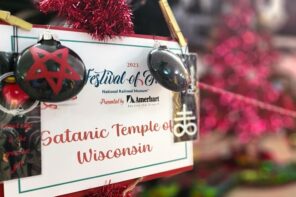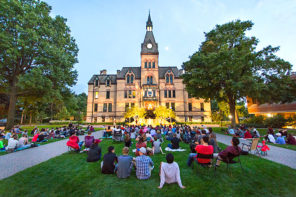Let me begin by stating what this article will not be doing: it will not be addressing the racist (but also vapid and unimaginative) bigotry coming from far right circles in the ‘mosque’ debate. Rather than attempting to deconstruct that ultimately banal rhetoric, I will focus on an issue that remains largely unaddressed: the troublesome terms and conditions upon which “Park51” has emerged a defensible endeavor within—not conservative—but liberal discourse.
In the past weeks, we have seen how liberal defenders have responded to the ‘fear and trembling’ that the mere idea of a mosque induces, through a series of disavowals. Instead of challenging the racist assumptions that buttress such rhetoric, many liberals have decided to offer ‘clarifications.’ Time and again, the public is being reminded of the fact that Park51 is not in fact a mosque but an Islamic community center that promotes ‘interfaith’ dialogue.
Daisy Khan and Imam Rauf, the leading figures behind the Park51 initiative, have not only repeated this mantra, but have in fact produced it. When liberal defenders have wittingly or unwittingly referred to Park51 as a mosque, the response from folks at the Cordoba Initiative has been gratitude in the form of this corrective: thank you for your support, but Park51 is not a mosque.
Desperate attempts to render inaudible the Community Center’s ‘Islamic’ origins have also included several name changes. Because the initiatives original name, Cordoba House, created a media explosion when it captured public imagination through the misnomer, “Ground-Zero mosque,” those spearheading the project felt that assuaging public fury required a complete erasure of its Islamic identity. A few weeks later, we were presented with ‘Park51,’ the most amorphous of its namesakes.
But these efforts (to present the Community Center as innocuous via its nomenclature) is just part of the problem; the very same rhetoric is being materially reproduced in the proposed design for Park51. The structure, as one of the artistic renderings being circulated in the media suggests, is a 13-story glass and steel building that literally looks nothing like a mosque. In the place of minarets or a crescent moon, we are asked to imagine the possible materiality of an eyesore that screams of capitalist excess. There appears to be some ‘Islamic’ influence in the geometric art that may be visible through its a glass exterior, but the aesthetics of this structure overwhelmingly suggest that its imagined design is a carefully constructed attempt at attracting as little attention as possible. If such a structure ever becomes a reality, the gaze of those working and visiting the area will seamlessly move from Park51 to the plethora of glass monuments that line the financial district, but it appears that this is precisely the point.
In all of this, it is clear that the kindergarten logic of “hear no evil, see no evil” is being utilized in order to sway public opinion in favor of the Center, but while the success of these maneuvers remains to be seen, its damage is immediately apparent. The message being sent is loud and clear: if Park51 ‘sounds’ nothing like mosque, claims to ‘be’ nothing like a mosque, and, ‘looks’ nothing like a mosque, then, and only then, does it emerge a defensible endeavor within the United States.
Selling a Sanitized Islam
Apart from the fact that these maneuvers do little by way of providing Americans with a reason to be self-reflexive—that is, to ponder the possibility of coexistence with Muslims without requiring, first, that those Muslims sanitize their identities and their places of worship—yet another danger exists in the fact that if these additives, this supplementary discourse (of community center and interfaith dialogue) continues to be the basis upon which Park51 emerges worthy of defense, then on what grounds will other mosques—which do not claim to be anything more or (perhaps, in Park51’s case) less than a mosque—be defended?
Other red flags emerge when we take note of how Imam Rauf and Daisy Khan’s ‘personal’ relationship to Islam (a relationship that associates itself with ‘sufi’ ideology and is identified as ‘moderate’ Islam) has been ascribed to Park51. When these disclaimers are showcased in the media, they are presented not as interesting facts about two individuals, but as some of Park51’s most ‘appealing’ features, a major ‘selling point’ in subsequent liberal discourse.
The narrative of fitting in, of assimilation and integration that is being established through Park51 produces a dangerous set of ‘if, then’ contingencies that we should all be wary of, and which index the precise problem of this moment in American history; a moment in which the terms and conditions being articulated in the Park51 debate have, in fact, already been established as the ground rules for determining who gets recognized as the ‘right’ kind of Muslim in America. Sadly, this ‘conditional’ recognition also suggests that only the claims of certain kinds of Muslims will be recognized as legitimate or worthy of defense.
As a Muslim, I take no pleasure in stating that I see no part of myself in what the Park51 initiative has become. The precise public identity that has enabled it to emerge a defensible endeavor in liberal discourse, has also had the damaging effect of alienating many Muslims—particularly those of us who do not wish to describe our relationship to Islam through language that seeks to ‘moderate’ not simply words, but the very conditions of our existence. To accept this insidious terminology would be tantamount to reinforcing the spurious claim that Islam, as it stands on its own—‘un-moderated’—is always already problematic.
However, while I will gladly pass on aligning myself with the liberal rhetoric I have critiqued here, it would be remiss to confuse this ideological disagreement with my unfaltering opinion that Park51 has every right to exist. This is not only because a minor document called the Constitution exists in order to safeguard this right, but because Muslims, like adherents of all religions, express their relationship to Islam in a multiplicity of ways. The problem of Park51 is not that it expresses one of those possible relationships, but that it produces its own relationship as not only the ‘right’ relationship (read: the most ‘tolerant,’ ‘enlightened,’ and ‘progressive’ relationship), but as the very foundation from which its existential claims emerge legitimate. I cannot, in good conscience, accept or reproduce this caricature as Truth.




